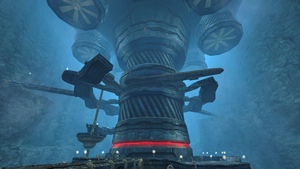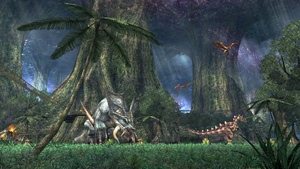There’s a long-awaited Wii roleplaying game out this Friday that you’ll want to start thinking about now, assuming you didn’t import the English-translation version when it hit Europe and Australia last fall. It’s called Xenoblade Chronicles, and yes, the “Xeno” before “blade” means it’s one of those games — the kind typecast by Western writers as “Japanese role-playing” and associated with pop-opera on a scale only exceeded in spectacle by James Cameron, Julie Taymor and Charlie Sheen. I say that because it’s inspired by (though not directly related to) the Xenosaga series and, before that, a semi-obscure PlayStation game that some might — blasphemy alert! — speak even more highly of than Final Fantasy VI. I might have been one of them.
I’ve only played six hours of XC so far, 12 including my restart at around the first six hour mark after what qualifies as the game’s introduction level. I was grooving on the mechanics and wanted a second pass to better absorb the preliminaries. I say “preliminaries” because, complex as the battle mechanics and socialization and crafting systems are already by the six hour mark (though never prohibitively so), I’m aware that what I’m doing at this stage may little resemble what I’ll be doing 30 or 40 hours further in, i.e. the game’s alleged halfway point. I keep hearing this is a game that changes its stripes as you go.
(MORE: What’s in the Next Xbox? Blu-ray, ‘Always Online’ Requirement Claims Site)

JRPG storytelling can be like listening to Der Ring des Nibelungen through a distorted guitar amp, but XC‘s conventionally unconventional story already has my attention with its tantalizing mysteries and “maybe I really haven’t seen this yet” narrative artifacts. The prologue involves two mythic titan-figures who emerge from another “this is how the world began” void and dance the “biological life” versus “artificial machine” cha-cha, trading blows until they freeze in place like two of Frank L. Baum’s Tin Man. The twist: Their bodies comprise XC‘s oddly-angled, multi-tiered world, as if someone fired a shrink-ray at Final Fantasy, then dropped it, flea-like, into one of Shadow of the Colossus‘ boss battles. Neat!
That’s the backdrop at the outset: You’re one of the organic lifeforms, charged alongside others with fending off incursions by mechanical hostiles, like the Lilliputians of Gulliver’s Travels by way of The Matrix. The game has its (or, more likely, just the first) Final Fantasy VII-esque shocker early on, which gets you properly worked up for a revenge quest framing an excursion to all the exotic “themed” areas populating these titans’ world-sized limbs, torsos and heads.
During the first six hours leading up to that moment, I’ve either been fighting stuff or wandering in search of stuff to fight, proving the counterintuitive maxim that roleplaying video games aren’t really about roleplaying at all. Instead, I’m shuffling between bits of one-way exposition and stop-the-clock diagnostic tinkering, but mostly the battles themselves. You initiate the latter by getting within range of standalone or grouped enemies (if they’re unfriendly, they’ll pick a fight with you) and tapping one of the gamepad’s triggers to pick an offensive action from a “battle palette.” (I’m playing with the classic controller, which I prefer, though the game also supports the Wii Remote and Nunchuk sans motion controls.) Attacks cycle Final Fantasy XII-style, so think realtime tactical as each combatant cycles through a turn-timer, but here there’s also a positional tactics angle, so you can mix it up by getting behind something and backstabbing or sideswiping to lay on debuffs. None of that’s unique, of course.

What is, is the way XC adds layers, first one, then another, then another still, gradually unearthing what turns out to be an archeological dig site’s worth of gameplay that somehow remains lean and workable. Take each character’s special ability, for instance, which by itself has damage-dealing limitations. Pair interdependent abilities in the proper situation and your mileage suddenly soars. Battles take on the coordination-based feel of basketball maneuvers: One person breaks through the defense, another drives the ball downcourt, a third sets up the shot…
(MORE: What if Sony’s So-Called ‘PlayStation Orbis’ Really Does Kill Used Games?)
Getting the sequencing right is the trick, of course, and that’s what’s so satisfying about bringing off an elaborate setup. It’s timing-based, and depends on your ability to track onscreen gauges as well as what phrases party members are shouting between actions, since they’ll announce their moves like characters in an arcade fighter. Don’t confuse any of that with a chain attack — the game adds those, too, to further deepen battle logistics, but here they involve selecting special abilities in immediate sequence — picking like-color-coded ones is preferred — to trigger even more extraordinary results. In some cases, executing a chain link is necessary to break through an enemy’s defenses: Fail to do so and your entire party’s blows will simply glance off your foes.
The battle system also benefits from what the game dubs “affinities,” a deceptively simple smiley-face metric for gauging how well characters like each other that’s improvable by pulling off trigger actions in battle or completing tasks outside combat that bolster your party’s relations. Party affinity feeds back into a rudimentary social-networking system that’s reflected in both your party’s relationship with a given locale as well as the individual relationships between citizens. Those relationships — viewable as line-links on a web-like “affinity” matrix screen — change as you carry out tasks on their behalf, trade with them or simply take the time (all of this is optional) to get to know them better. And that can lead to game bonuses, but also a deeper sense of the game world, who the people are you’re fighting for and how they get on with each other. The human interest level is still pretty surface-level, but the way people interlink (and your ability to influence those links) is more satisfying, say, than crawling dialogue trees and checking off encounters like lines on a to-do list in games like Dragon Age or Mass Effect.
 Most of the two or three dozen tasks I’ve completed so far have been either kill-a-creature or fetch-something-for-me, e.g. collect two of some medicinal oil, mend a broken watch, defeat three of whatever killer rabbit-crab-bat-bird, etc. But we expect hunt-quests in games like this. What we don’t but ought to — and what XC delivers in inspiring ways — is the way all that can be streamlined to mitigate the drudgery. Most quests in XC finish with rewards delivered as soon as you meet their requirements, eliminating tedious turn-in backtracking. If you’re out in the field, you can stay out in the field, leveling up as you like without tracking down quest-givers (a few of the latter type exist, to be fair, but they’ve so far been the exception). If you want to fast-travel, you can skip around to any visited landmark instantly. If you want to save or load, you can do that anywhere. If you’re killed, you lose nothing and simply appear at whatever landmark you last passed. The underlying maxim: If it’s donkey work, chuck it. While XC has at least some of the DNA of older roleplaying systems, it’s much more limber.
Most of the two or three dozen tasks I’ve completed so far have been either kill-a-creature or fetch-something-for-me, e.g. collect two of some medicinal oil, mend a broken watch, defeat three of whatever killer rabbit-crab-bat-bird, etc. But we expect hunt-quests in games like this. What we don’t but ought to — and what XC delivers in inspiring ways — is the way all that can be streamlined to mitigate the drudgery. Most quests in XC finish with rewards delivered as soon as you meet their requirements, eliminating tedious turn-in backtracking. If you’re out in the field, you can stay out in the field, leveling up as you like without tracking down quest-givers (a few of the latter type exist, to be fair, but they’ve so far been the exception). If you want to fast-travel, you can skip around to any visited landmark instantly. If you want to save or load, you can do that anywhere. If you’re killed, you lose nothing and simply appear at whatever landmark you last passed. The underlying maxim: If it’s donkey work, chuck it. While XC has at least some of the DNA of older roleplaying systems, it’s much more limber.
So far, so good then. I have no idea how well XC scales in the later hours, whether killing stuff in area after area will eventually numb me to the battle mechanics, how well the apparently mad-elaborate item crafting system I just discovered works, how much deeper the affinity social-networking rabbit hole goes and whether the story’s going to flip my lid or just pry it up a little before tamping it back down prosaically. But I’m hopeful.
[Note: This is part of a Xenoblade Chronicles review series. Keep an eye on our Game Time section for further installments.]
MORE: ‘Assassin’s Creed III’: On Slavery, Native Americans and Death-Dealing Gameplay

